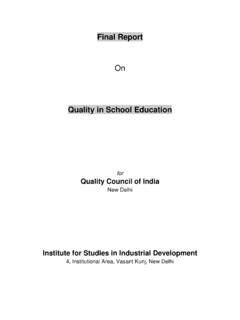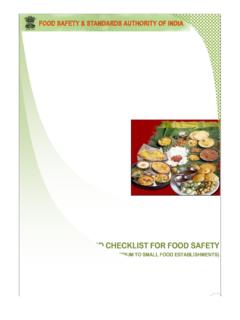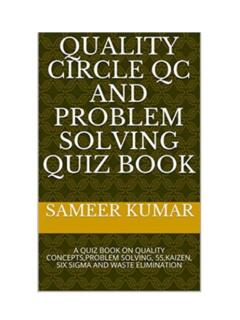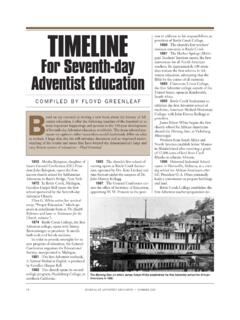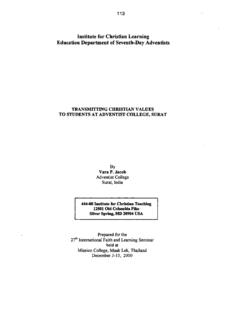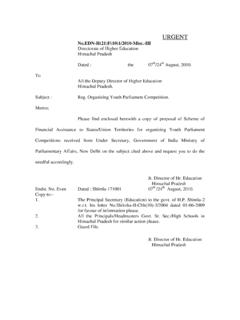Transcription of Quality in School Education - Quality Council of India
1 Final Report On Quality in School Education for Quality Council of India New Delhi Institute for Studies in Industrial Development 4, Institutional Area, Vasant Kunj, New Delhi i CONTENTS Page Content i ii List of Tables v iii List of Boxes vi iv List of Figures vi v Abbreviations vii-ix 1 Chapter 1: Introduction Quality Concern in Education School Education System under Different Boards School Boards in India Education system under CBSE, ICSE, IB and Delhi Govt.
2 Schools CBSE - Central Board of Secondary Education Council for the Indian School Certificate Examinations (CISCE) Indian Certificate of Secondary Education Indian School Certificate International Baccalaureate Organization (IBO) International School Education Boards in India IB Programmes Delhi Board (DB) Basic Items Covered Under Study Curriculum Extracurricular activities Co-Curricular Activities (CCAs) & Extracurricular Activities (ECAs) Pedagogy Syllabi at Different Stages Affiliation Is School Affiliation necessary? Accreditation standards Is School accreditation necessary? 1-16 2 Chapter 2: Need for the Study Objectives of the study Review of Literature Research in Curriculum General Curriculum Co-curricular Activities Pedagogy Methods of Study Area of the Study Literature Survey Sample Size and the list of the Schoosl covered under the Study Study Framework Field study Comparative Methods Tools and Techniques used for the Data Collection Observation Methods Comparative Assessment of Good Practices (in CBSE, ICSE, IB, and 17-36 ii Page Govt.)
3 Schools) School Routine Activities School Safety and Vigilance Measures School Governance and Monitoring Activities School Health and Hygiene Co-curricular Activities School Teaching-Learning Processes School Sanitation and Gardening Activities Learners Performance Monitoring Activities Hobby Development Programme School -wise Quality Percentage Achievement with Reference to Some Major Quality Indicators Infrastructure Physical Environment Teaching-aids Classroom Dynamics Quality Parameters Work Culture Monitoring and Supervision 3 Chapter 3: Accreditation and Affiliation How the affiliation bodies carry out inspection? Council for the Indian School Certificate Examination (CISCE) Central Board of Secondary Education (CBSE) Delhi Government Schools International Baccalaureate Organization (IBO) Is the Inspection one time or Continuous?
4 Council for the Indian School Certificate Examination (CISCE) Central Board of Secondary Education (CBSE) Delhi Board International Baccalaureate Organisation (IBO) Actual Compliance Status of affiliated Schools 37-47 4 Chapter 4: Curriculum and Syllabus Curriculum: CBSE, ICSE, IB and Delhi Government Schools Comparative Study of Curriculum in Different Boards Curriculum of CBSE, ICSE, IB and Delhi Govt. Schools Similarities in Objectives and Approaches Curriculum of CBSE, ICSE, IB and Delhi Govt. School Differences in Objectives and Approaches Syllabi of CBSE, ICSE and IB A Comparative Study What is the main Difference between ICSE, CBSE and IB syllabus? Concluding Remark 48-57 5 Chapter 5: Examination and Evaluation Procedures Examination Evaluation / Assessment The Concept of Continuous and Comprehensive Evaluation (CCCE) CBSE Examination and Evaluation Pattern 58-91 iii Page No.
5 Evaluation Pattern Continuous Assessment (60%) Final Examination (40%) MOTS to HOTS (CBSE) Different Streams Council for the Indian School Certificate Examinations (CICSE) Examination Classes I-VIII Examination and Evaluation System Indian Certificate of Secondary Education (ICSE) Examination (IX-X) Indian School Certificate (ISC) Examination (XI-XII) Different Streams IB Examination and Assessment Primary level (Grade I V) How IB PYP students are assessed? Type of Assessment Middle year Programme (Grade VI- X) MYP Assessment Continuous Assessment Final Assessment Validation of Grades How IB MYP students are assessed? The role of examiner Training Diploma Programme (Grade XI-XII) Nature of the Assessments Grading Assessment of Diploma programme The Diploma Programme goals provide students with: Basic skills: GPA weightage of IB Courses IB Diploma Continuous Assessment Delhi Govt.
6 School : Examination and Evaluation Procedure Examination and Evaluation in different Boards (CBSE, ICSE, IB and Delhi): A Comparative Analysis Some Common Types of Questions in CBSE, ICSE, IB and Delhi Govt. Schools Compliance Status of Examination and Evaluation of Studied School Concluding Remarks References Annexure 92-299 6 Annexure 1: Some Basic Queries on Curriculum (CCA, ECA and pedagogy), Syllabus, Examination, Affiliation and Accreditation Standards 92-97 7 Annexure 2: Norms for Affiliation as per Central Board of Secondary Education (CBSE) Affiliation Bye-Laws 98-104 8 Annexure 3: Affiliation Requirements according to the Council for the Indian School Certificate Examinations (CISCE) Affiliation Guidelines 105-111 iv Page Annexure 4: IB School Authorization Procedure 112-116 10 Annexure 5.
7 Basic Items Covered under Study 117-182 11 Annexure 6: List of some of the Good Practices 183-191 12 Annexure 7: School -wise Status 192-200 13 Annexure 8: Study of Curricula, Pedagogy, CCA and ECA in Different Boards (Similarities) 201-204 14 Annexure 9: Study of Curriculum, Pedagogy, CCA and ECA in Different Boards (Differences) 205-210 15 Annexure 10: Class-wise CBSE Syllabus 111-219 16 Annexure 11: Class-wise ICSE Syllabus 220-224 17 Annexure 12: Class-wise IB Syllabus 225-231 18 Annexure 13: Different types of curricula used in schools today 232-233 18 Annexure 14: NABET Accreditation Checklist 234-237 19 Annexure 15: CBSE Examination and Evaluation Pattern 238-243 20 Annexure 16: CBSE Evaluation Pattern Class I-XII 244-245 21 Annexure 17: CISCE Examinations and Evaluation Pattern 246-248 22 Annexure 18: ICSE Evaluation Procedure at class IX-X 249-252 23 Annexure 19: How will we know what we have learned?
8 Assessment in the PYP (Grade I V) 253-255 24 Annexure 20: IB MYP (Grades VI-X) Assessment 256-271 25 Annexure 21: IB Diploma Examination and Assessment 272-291 26 Annexure 22: IB Examination and Evaluation Pattern 292-295 27 Annexure 23: Sample: (Chemistry) IB Internal Assessment Marking Scheme 296 28 Annexure 24: Questionnaire Examination and Evaluation System 297-299 29 Annexure 25: Summary of Key Features of CBSE 300 30 Annexure 26: Summary of Key Features of CISCE 301 31 Annexure 27: Summary of Key Features of IB 302 v List of Tables Title Page No. 1 Table: Sample size and the list of schools covered under the study 25 2 Table: Hariharanand Public School 27 3 Table: Konark Public School 28 4 Table: Kendriya Vidyalaya 28 5 Table: Sanskriti School 28 5 Table: GBSS, Puram Sec-2 29 7 Table: GBSS, Puram Sec-3 29 8 Table: American School of Bombay 29 9 Table: Poddar International School 30 10 Table: American Embassy School , Delhi 30 11 Table: Status ( Quality %Achievement) of Some Good Practices 31 12 Table: School -wise Status ( Quality %Achievement) 36 13 Table: The Frequency of Inspection of Schools by Different Boards 41 14 Table: Actual Compliance Status of affiliated Schools 43 15 Table: Comparative Study of Affiliation / Accreditation Standards of CISCE, CBSE, IB and Delhi Govt.
9 Schools. 44-47 16 Table: Designing Curriculum and Syllabus of Different Boards 49 17 Table: Class- wise and School -wise pedagogy of CBSE, CISCE, IB and Delhi Govt. Schools 52-53 18 Table: Class- Wise Distributions of Subjects, Tests and Examination (CBSE) 63 19 Table: Classes X and XII: Examination and Marks Division (CBSE) 63 20 Table: Instruction Time per Week of Teaching Time: Class X (CBSE) 64 21 Table: Instruction Time per Week of Teaching Time: Class XII (CBSE) 64 22 Table: Types of Questions and Value Points (CBSE) 65 23 Table: Value Points and Grades(CBSE) 65 24 Table: Grade point Range and Grades (CBSE) 65 25 Table: Classes VI-VIII: Examination and Marks Division (CBSE) 66 26 Table: Types of Subjects (CBSE) 66 27 Table: Classes X and XII Different Dimensions of Question Papers and respective Weightage (CBSE) 67 28 Table: Stream Wise Subjects for Classes XI-XII (CBSE) 69 29 Table: Exam Schedule (ICSE) 70 30 Table.
10 Evaluation Pattern from Classes I to VIII (ICSE) 70 31 Table: Grading Scale and Weightage System (IB) 79 32 Table: Assessment Weight of Coursework (IB) 81 33 Table: Evaluation Procedures in Delhi Board (Delhi Govt. Schools) 84 34 Table: Similarities in Examination and Evaluation in Different Boards (CBSE, ICSE, IB and Delhi) 86-87 35 Table: Differences in Examination and Evaluation in Different Boards (CBSE, ICSE, IB and Delhi) 88-89 36 Table: Compliance Statuses of Schools Affiliated with Different Boards 90 vi Title Page No. Boxes 1 Box: Definitions of Key Concepts 3 Box: Key Definitions in the context of School Education 58 Box: Major Sources of Students Testing by CBSE, ICSE, IB and Delhi Govt.
